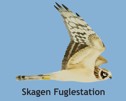
|
|
Autumn migration is extended in time Simplified overview of the changes in the median migration date for the 75 species in the monitoring. They are divided by early-migrating (median date 15 July–14 September) and late migrating species (median date 15 September–15 November). The timing of bird migration in autumn is changing
On the report, partly written by Lista BO, a total of 75 species were analysed based on the bird observatories' 32-year time series (1990-2021). The results show a marked difference between species that migrate early and late in autumn. Difference between early and late migrants (in autumn). The estimates are as follows: • Long-distance migrants (early migrants) start departure on average 2-3 days earlier. • Short-distance migrants (late migrants) start departure on average 3-4 days later. • The length of the autumn migration when most species migrate has been extended by 5.6 days from 1990 to 2021. In the study from the two bird observatories, 21 species from the standardized trapping and 54 from the observations were analysed. The general tendency from these two different methods was very similar. A total of 17 species show significant changes in the estimated (median) migration time in autumn. The species that migrate significantly earlier are Greylag Goose (18 days), Red Knot (11 days), Dunlin (12 days), Common Redshank (4 days), Sand Martin (13 days), Willow Warbler (9 days), Chiffchaff (7 days) and Common Redstart (7 days). On the other hand, there are nine species that show a significant change towards a later migration in the autumn. Here we find Eurasian Wigeon (10 days), Long-tailed Duck (11 days), Goldeneye (9 days), Stock Dove (15 days), Common Buzzard (11 days), Peregrine Falcon (6 days), Common Magpie (15 days), Western Jackdaw (9 days) and Blue Tit (8 days). Causes and consequences There is variation between species in how much a departure can change, as there are many conditions that can regulate this. High variation in the number of clutches throughout a season, variation within incubation time and time of fledgling, moult strategies, and the need for fat storage before migration are examples. It is not clear whether these variations are due to more permanent adaptations to the climate change or plastic responses to annual climate variations. The earlier departure of long-distance migrants may be related to the fact that they are mostly single-brooded species, as well as a selection pressure to migrate through the Sahel region before it becomes too dry before winter. For some species that migrate late in the autumn, the departure has been linked to a change in when the species are triggered by, for example, temperature. Although increased temperature and delayed migration can mean that birds migrate under similar temperature conditions during their main migration period, it is possible that some migratory birds experience tougher conditions during a later migration. Conclusions The main conclusion from the analysis is that the early migrating species now generally migrate earlier in the autumn than in 1990, while the species that migrate late in the autumn migrate later than they did in the past. This makes an extension of the migration period making that the migration season is longer in time. Our results show that it will be important to separate species with different ecosystems in a further analysis of phenology changes for a wide range of species. A closer analysis of the autumn migration could be done, where a clearer distinction is made between early and later migrants and partially overwintering species will probably provide more detailed knowledge. The large data set with long time series from Jomfruland and Lista bird observatories, both from standardized trapping and observations, has become an important collection of easily accessible and very valuable data. Such time series makes possible to carry out multiple studies and is particularly relevant to examine long-term changes in migration patterns that can be compared with trends in climate data. The Norwegian Environment Agency has published an item about this report, see here: Climate change modifies bird migration | The Norwegian Environment Agency (ntb.no). | ||||||

| Ringing numbers | ||||||||||||
|
| Reportasje fra Lista FS i Aftenposten |

|
| Seasonal deviation | ||||||||||||||||||||||||||||||
|
|
Følg Følg Lista FS på facebook.com |
| Siste 5 på siden |
|
Begynnerkurs i ringmerking: 17.-18. august The annual report for 2023 is available! Fuglefestival 2.-3. september Report from spring 2023 Ny rapport: Måling av elektromagnetiske feltstyrke fra fugleradar ved Lista fyr. |
| Nyheter fra NOF |
|
Lille måltrost og den enda... Fine hekkeflåter til ternene... Statsforvalteren sier nei til... Hotell i særklasse Tusenvis av svarttrost: Hvor... Kulturlandskapsarten... BirdLife Norge reagerer på... Hva vet vi om svartand i... |
Lista Fuglestasjon
Fyrveien 6
NO-4563 Borhaug
post@listafuglestasjon.no Tlf: 949 86 793
 |  |


 Only in English
Only in English



